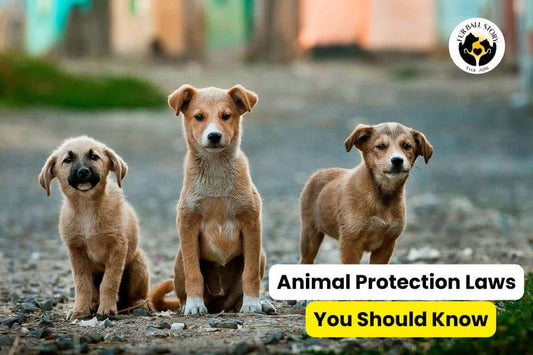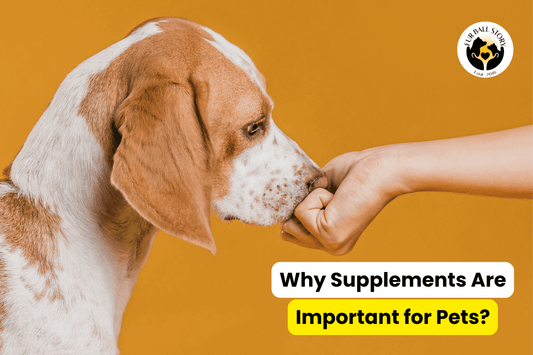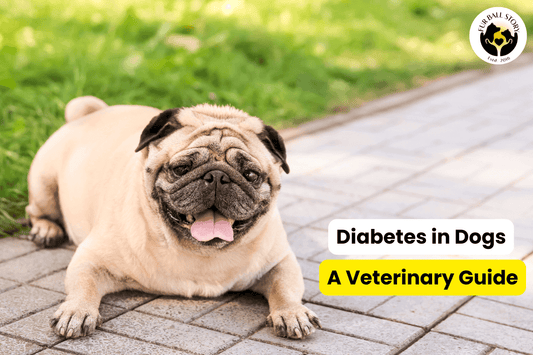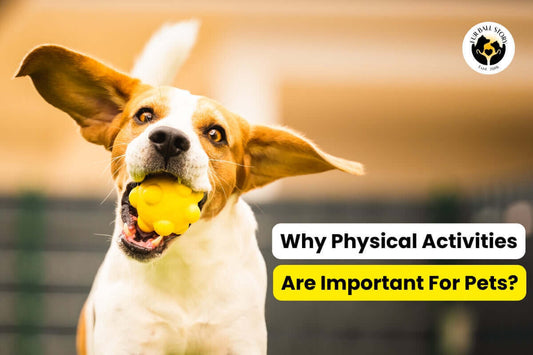"Purr-fect Pet Parenting: Tips, Advice"

Help Your Pet Live Longer: 5 Essential Pet Heal...
How amazing it would be if our pets could stay a little longer with us! The good news? You can make this dream come true by simply adopting 5 healthy...
Help Your Pet Live Longer: 5 Essential Pet Heal...
How amazing it would be if our pets could stay a little longer with us! The good news? You can make this dream come true by simply adopting 5 healthy habits. With a few essential lifestyle changes, you can help your furry friend live a longer, happier life. Wondering what these habits are? Read on Help Your Pet Live Longer: 5 Essential Pet Health Care Tips that can make big difference in your pet's health and longevity. 1. Better Diet, Better Life We all strive to provide the best life to our dogs, but little do we know that their diet plays a crucial role in achieving this goal. Being attentive to your pet’s eating habits prevents chronic conditions like diabetes and high blood pressure. Many of these problems arise from poor feeding habits including excessive salt or sugar consumption. By being mindful of what you feed your pet, you can avoid these health risks and keep them feeling their best. 2. Know About Poisonous Foods A dog’s curiosity can sometimes get them into trouble, especially when it comes to food. Common food items like chocolate, grapes, raisins, caffeine, alcohol, sugar-free gums, and certain nuts can be toxic, leading to upset stomach and serious health issues like kidney failure or seizures. While these foods can be staples in your kitchen, it is essential to keep them well out of your dog’s reach. Must Read: Things Your Should Avoid Feeding To Your Dog 3. Stop Ignoring, Start Acting Whether we see our pet vomiting, dealing with ticks, or detect an unusual lump, we hope the issue resolves on its own and often neglect them. However, ignoring these underlying signs can lead to significant health consequences such as kidney failure or even cancer. It is highly important to address these problems promptly and seek veterinary advice immediately. Don’t wait for the situation to get better as early detection and treatment can save your dog’s life. 4. Physical Activities Are A Must In India, pet parents often overlook the importance of regular physical activities. Incorporating daily walks and dedicated playtime into their routine has a profound impact on their physical and mental health. These activities not only help utilize excess energy but also prevent health issues like obesity and anxiety, thereby keeping them healthy. Also check out: Why Physical Activities Are Important For Pets? 5. Regular Vaccination & Veterinary Visits It is alarming that over 60% of pet parents neglect their dog’s vaccination and many believe that only puppies need vaccines. This common misconception is putting pets at great health risk. While in reality, adult dogs need regular vaccinations too, as these shots protect them from serious diseases like rabies, distemper, and leptospirosis. Keep your dog safe and protected with regular vaccination & veterinary visits. A Special Gift For Your Furry Friend! SuperTonic Syrup by Fur Ball Story is the secret to maintaining your pet’s long-term health! This all-natural syrup boosts immunity and protects your furry friend from numerous diseases. Recommended by vets and available in a tasty vanilla flavor, it promotes head to tail wellness of every pet. Just 1 spoon a day keeps the sickness away! Key Takeaway It’s never too early to start making positive changes for your pet’s health. By following these essential tips, you can commit to your pet’s long-term health and happiness. So why wait? Start making these changes today, and enjoy many more years of unforgettable memories, wagging tails, and playful moments with your furry friend. Remember, their health and happiness are in your hands and every mindful decision adds up to their longetivity.

Animal Protection Laws in India You Must Know
As the cases of animal cruelty surge in India, it brings a need to protect our furry companions. These innocent yet voiceless creatures rely on us to speak up for...
Animal Protection Laws in India You Must Know
As the cases of animal cruelty surge in India, it brings a need to protect our furry companions. These innocent yet voiceless creatures rely on us to speak up for their rights. So here are Animal Protection Laws in India You Must Know as per the Constitution to ensure their safety. Whether preventing abuse or conserving endangered species, animal protection laws are critical to maintaining a just world for all living beings. This blog will help you discover the most important animal protection laws to help reap a better future for animals around us. Sections 428 & 429 According to Sections 428 and 429 of the Indian Penal Code (IPC) of 1960, any type of Animal Cruelty or abuse is illegal. This includes the following illegal activities: Killing- It is illegal to kill any animal. Any individual found guilty is liable to pay a hefty fine and/or imprisonment of 2 years. Maiming- Maiming an animal means to cause a lasting injury or damage to it, often resulting in the loss of a body part. For example, if an animal is hit by a car and loses a limb, that would be considered maiming. Poisoning- Intentionally feeding poison to any animal is also a punishable offence under section. Rendering Useless- Deliberately hurting an animal so that it is not useful to the owner. For instance, hurting the udder of a milking animal, so that the owner faces financial losses. Dislocating- Moving any animal from the place they are living for personal benefit. Abduction- Keeping any animal that belongs to someone else for personal benefit. If any individual violates any of the above laws, it is considered punishable under sections 428 & 429 and they can be charged a fine and/or imprisonment of up to 5 years. Section 377 According to Section 377 of IPC, if any human indulges in any kind of sexual intercourse with any animal, it is considered an offence "against the order of nature”. This act is punishable with life imprisonment, imprisonment up to ten years, and/or a fine. Article 51 A(g) There is a common misconception in India that feeding strays is illegal. However, this notion is not true. Rather, the Constitution of India supports the right of citizens to show compassion towards all living creatures including strays and to feed them, under Article 51A(g). Prevention of Cruelty The Prevention of Cruelty to Animals Act of 1960 is an Act of the Parliament of India that prevents the infliction of unnecessary pain or suffering on animals and to amend the laws relating to the prevention of cruelty to animals. The act defines "animal" as any living creature other than a human being. The Prevention of Cruelty to Animals Act (PCA) of 1960 has four chapters: Chapter I: Preliminary Defines animals and owners, and sets out the duties of those responsible for animals. Chapter II: Animal Welfare Board of India (AWBI) Defines the mandate and powers of the AWBI, and details its constitution, term of office, funding, and functions. Chapter III: Cruelty to Animals Generally Deals with treating animals cruelly, the penalty for practising phooka or doom dev, and the destruction of suffering animals. Chapter IV: Experimentation on Animals Deals with experiments on animals, the committee for their control and supervision, and the power to prohibit experiments. The Prevention of Cruelty Act was enacted to ensure that animals are treated without cruelty and are free from unnecessary pain and suffering. Having knowledge of such laws is important for every pet parent as well as animal lover because to empower them. Let's come together to be a voice for the voiceless!

Importance of Supplements for Dogs and Cats
The Indian pet industry is full of myths. One such widespread myth in the Indian pet industry is the confusion between supplements and medicine, causing many pet owners to avoid...
Importance of Supplements for Dogs and Cats
The Indian pet industry is full of myths. One such widespread myth in the Indian pet industry is the confusion between supplements and medicine, causing many pet owners to avoid them. However, this is not true. Supplements are not medicines; they are a crucial way to provide essential nutrients that may be missing from your pet’s diet. Let’s bust the myth and explore how the right supplements can be a game-changer for your pet through this Importance of Supplements for Dogs and Cats. Signs Your Pet Needs Supplements Frequently eating soil Licking their own pee or poo Bending of Legs Immense Hairfall Low Immunity Recurrent Digestive issues- Vomiting, Diarrhea Skipping Meals or not finishing them If your pet is showing any of the above signs, it can be due to a deficiency of nutrients. To meet this deficiency, supplements should be added to their routine. Moreover, you can save your pet from several diseases by giving them supplements. Which Supplements to Choose? Some of the primary supplements that are of utmost importance are: Multivitamins and multiminerals Skin Supplements Pre and probiotics Appetite Stimulant Immunity Boosters Importance of Supplements 1. Multivitamins and multiminerals There are several diseases that can be prevented by providing a good source of multivitamins and multi-minerals. It is nearly impossible to meet all the bodily requirements solely through home-cooked meals or commercially prepared feeds. It is important to build a bridge in this nutritional gap. Try CanniVin Multivitamin Supplement now and provide essential nutrients instantly within 3 seconds! 2. Skin Supplements Every pet requires some or the other skin supplements like omega 3 and 6 fatty acids which help in proper growth and nourishment of skin and also help to prevent many kinds of skin issues by maintaining the skin barrier. If you have a dog with a heavy fur coat then all the more reasons to buy such supplements, along with good combing and grooming habits you need to include these supplements too, for a healthy and shiny coat. Get CanniVin Spray now to ensure Healthy Skin, Shiny Coat and tackle the root cause of skin problems. 3. Pre and Probiotics Frequent vomiting or loose stool, is your dog facing similar issues? Then this can be a sign of poor gut health. Taking immediate action is necessary as this can be the reason why your pet is not able to gain weight because his body is not able to absorb the nutrients of food. All this can lead to lower levels of immunity, so make sure that your dog’s gut health is maintained because it indirectly affects many aspects of his nutrition. Relieve your pet's digestive issues with Pacho Pet, a natural syrup approved by vets. 4. Appetite Stimulant Your dog eats very less, some time he skips the whole meal and other time he eats a very small portion of it, this could be an indication that he needs an appetite stimulant, some sort of liver tonic. Because you need to understand the whole body’s growth depends upon the food your dog takes. So it is very important that there is proper intake of food. To turn any food 10x tasty and healthy with Wag Boost, a pet food topper. 5. Immunity Booster There are many dogs who are low in immunity, which can be due to so many reasons like not getting mother milk in the initial days of birth, poor diet, infections at an early stage of life. Supertonic is one such immunity booster that enhances your pet's head to tail wellness with natural ingredients. It improves both physical and mental health of dogs and cats. To Sum Up Supplements play a vital role in keeping our pets happy, healthy, and thriving. Whether it's joint support, digestive health, or a shiny coat, the right supplement can make a world of difference in your pet's overall well-being. Always consult your vet to choose the best supplements suited for your pet’s unique needs, and give them the extra care they deserve. After all, a healthy pet is a happy pet!

5 Best New Year Resolutions For Pet Parents
As the New Year rolls in, many of us make resolutions to improve ourselves. But for pet parents, it's also the perfect time to reflect on how we can make...
5 Best New Year Resolutions For Pet Parents
As the New Year rolls in, many of us make resolutions to improve ourselves. But for pet parents, it's also the perfect time to reflect on how we can make the lives of our furry companions even better. Whether you are a new pet parent or a seasoned one, setting resolutions for your pet can strengthen your bond and ensure their health and happiness. Here are 5 Best New Year Resolutions For Pet Parents to ensure a fulfilling year for both you and your furry friend. Regular visits to vet Weight Management Avoiding Treats Spending Time with Your Pet Gifting Your Pet 1. REGULAR VISIT TO A VET This year, prioritize your pet’s health with regular veterinary visits, not neglecting their needs or postponing vaccinations. Regular check-ups and tests are essential, especially for older pets, to detect any health risk at early stages. Ensure your pet receives their annual vaccinations without fail to protect them from preventable diseases. Routine vet visits are key to maintaining your pet’s overall well-being and ensuring they live a long and healthy life. 2. WEIGHT MANAGEMENT Managing your pet’s healthy weight is key to their wellness. From this year, focus on your pet's health by ensuring they maintain a healthy weight. If your pet is overweight, it is important to recognize the risks including reduced life expectancy and an increased likelihood of diseases like diabetes, high blood pressure, joint issues, and heart problems. On the other hand, if your pet is underweight, it may be due to an improper diet or underlying chronic illnesses. So provide a balanced diet and seek veterinary advice to identify and address any health concerns. 3. AVOIDING COMMERCIAL TREATS If you also have the habit of feeding commercial treats to your pet, then start this new year by promising to reduce their use and eventually stop using them. The preservatives and sugary ingredients they contain can be very harmful to pets. Their excess intake leads to obesity, cancers, kidney and liver-related problems. So make sure to gradually cut them off your pet’s diet. 4. TAKING OUT TIME FOR YOUR PET The bond with our furry friends is incredibly precious. While life can get busy, it is important to remember that our pets only crave our time and attention. A few moments spent with them can mean the world to them while bringing immense joy and strengthening the connection. This New Year, make a promise to devote generous time daily to your pet whether it’s a walk or a simple cuddle, or simply cuddling them. Nurturing this special bond will create memories that last a lifetime. 5. GIFTING YOUR PET We often start our new year by taking gifts for our loved ones and starting the year with them. So this year, even if you make plans for going out, take your pet with you and start the new year with them. Also get a gift for them because remember all they have is “YOU”. Check out Top 5 Christmas & New Year Gift Ideas for Pet Parents. To Sum Up Don't miss the golden opportunity for growth, and that goes well for your pet too! By making these small but impactful changes, you can ensure that your pet stays fit and active throughout the year. Whether it is improving their diet, increasing exercise, or simply giving them more attention, every effort counts. Here's to a year of stronger bonds, health, and happiness for both you and your beloved pet. HAPPY NEW YEAR TO YOU AND YOUR FUR BALL!

Top 5 Christmas & New Year Gift Ideas for Pet P...
For pet parents, nothing can beat the happiness of giving and receiving unique gifts for their fur babies. Check out ‘5 Christmas & New Year Gift Ideas for Pet Parents'...
Top 5 Christmas & New Year Gift Ideas for Pet P...
As the World's most awaited season approaches, it's time to surprise our loved ones. The festivities are celebrated best when coupled with the joy of gifting favourites to people around. While for pet parents, nothing can beat the happiness of giving and receiving unique items for their fur babies. Wondering what these unique items can be? Whether you are a pet parent searching for some amazing gift ideas for your pet or planning to give something special to a fellow pet parent, we have got you covered. Check out our blog on ‘5 Christmas & New Year Gift Ideas for Pet Parents’ below and make gifting even more valuable. 1. Natural Products Natural and herbal pet products are currently stealing the trend, not only for humans but for their furry friends too. With pet parents trusting more on natural products for their fur ball, pet grooming products are the best choice. There are thousands of options available in the market, you can opt for a natural dog shampoo, moisturizer, dental spray and more. These products can even be used around the year, making it a suitable choice. Check Out our Natural Range of Petcare Products. 2. Regular Care Products When choosing a gift, people always think of something meaningful. So what's better than gifting a combo pack? At Fur Ball Story, we have specially curated combos and kits that cater to the specific healthcare needs of every pet. Find an exclusive range of combos for skin, healthcare, tick preventives, digestive and deworming kits, nutritional packs and more. Considering the lasting worth of these products, this is a gift that holds the best value for money. 3. Festive Specials During festive season, the noise of crackers, loud music and guests around, pets often face severe anxiety and stress. However, with some extra love and care, pets can easily be comforted. Opt for safe anxiety tablets like Calm Pet, made using natural ingredients such as Ashwagandha and Guduchi. It not only calms anxiety but is also perfect to boost the mental wellness of dogs and cats. So for this occasion, Calm Pet is one of the most thoughtful gifts that you can give to a pet parent. 4. Range of Health Supplements Pamper every fur ball with India’s most potent range of healthcare supplements like CanniVin. From healthy skin and shiny coat to multivitamin sprays, you can find premium supplements with us. The peanut butter flavour of this nutritious spray makes pets drool over it. Moreover, the easy-to-use technology and instant absorption within 3 seconds help to supply essential nutrients to the body. Pet parents all across the country have shown love for these supplements, making CanniVin Range of Supplements a healthy and tasty gifting option. 5. Petcare Necessities There are some necessities that every pet parent should have and also equip them to meet any challenges in their pet parenting journey. Fur Ball Story's pet-friendly first aid kit is the best choice. This 12-in-1 kit features basic necessities like a bandage, thermometer, cotton, etc. to Ayurvedic healthcare essentials like a digestive booster, fever relief, tick preventives and more. With an easy-to-carry design and a selection of Ayurvedic products, this First Aid Kit is a must-have for every pet parent and an incredibly useful gifting item. Celebrate Like Never Before! This season, celebrate by choosing gifts that appreciate your fur baby’s love and dedication. Whether it is a trending item or a personalized gift, these thoughtful surprises are sure to bring joy to any pets and their parents. Acknowledging the immense joy pets bring to our lives makes the festive season even more meaningful.

Celebrate New Year 2025 With Top 10 Petcare Tips
The festival of lights, joy and celebration is just around the corner. With preparation at its peak, it’s time to get your furry friend ready too. Here are some important...
Celebrate New Year 2025 With Top 10 Petcare Tips
The festival of lights, joy and celebration is just around the corner. With preparation at its peak, it’s time to get your furry friend ready too. Here are some important pet care tips to ensure that your fur baby stays safe and calm during this festive season. Check out our blog on ‘Celebrate New Year 2025 With Top 10 Petcare Tips’ and find the most useful strategies to add to the joy of celebrations for you as well as your pet. 1. Create a Safe Space Figure out a quiet space in your home where your pooch can relax when anxious by the noise of crackers. Include toys, a comforting bed and a blanket to help them feel safe. Keep the windows and doors closed to muffle the sound, and consider playing calming music. 2. Resolve Anxiety Issues As pets get anxious due to crackers and loud noise, they often face issues like sleeplessness, lack of appetite, frequent urination, isolation in corners and more. To prevent this issue, Fur Ball Story brings to you Calm Pet. A vet-approved, Ayurvedic medicine to relieve stress and anxiety during the festive season. 3. Balance Human Interactions Your guests and people around would want to greet your pet, which might be overwhelming. So it becomes important to introduce them slowly or let them have their space, especially if your pet is shy or anxious. Inform your guests about your pet’s needs and encourage them to be gentle and calm around your pets. 4. Keep them Hydrated Ensure your pet has access to fresh water at all times. Hydration is key, especially if they are feeling anxious. So keep their water bowls filled and remember to change the water within a few hours. 5. Pet-Friendly Decorations Some of the items for decoration such as flowers, lights, candles, sweets and nuts can be harmful to pets. As some pets may chew these toxic items or their fur might catch fire. Be careful and avoid choosing items that can harm your pet. 6. Spend time with your Pet Give your pets quality time as your presence can provide reassurance and ease their stress. Include them in the celebrations, dress them in comfortable festive attire and involve them during your meal time. 7. Keep a First Aid Kit Ensure you have a pet-friendly first aid kit at home which includes bandages, antiseptics, and any medications. Besides, pets may also suffer from indigestion, fever or skin allergies during the festive season. To resolve this issue, Fur Ball Story’s First Aid Kit is here. It equips you with basic necessities along with 100% Ayurvedic, Vet Approved and Natural medicines to relieve common health issues at home. 8. Maintain Regular Routine Make sure you do not make changes to your pet’s usual routine such as feeding times and walks. Familiar regular activities ensure comfort at chaotic times. 9. Pet-Friendly Treats Try making DIY treats or buying pet-friendly treats that cater to their dietary needs and keep them safe while enjoying the celebrations. 10. Gift hampers for pets Surprising your furry friend with new toys, treats and grooming essentials during the festivities makes them feel special and distracts them from the hassle going around. With a little affection and care, festivals can be a joyful experience for you and your furry companion. Enlighten the festive spirit while keeping your pets calm and comfortable. Happy New Year to you and your pets!

Diabetes in Dogs: Types, Causes, Signs & Preven...
There is a big misconception that dogs are not prone to diabetes which is completely wrong rather dogs catch it very often especially if your feeding habits are wrong. What...
Diabetes in Dogs: Types, Causes, Signs & Preven...
There is a big misconception that dogs are not prone to diabetes which is completely wrong rather dogs catch it very often especially if your feeding habits are wrong. What is Diabetes? Diabetes is a chronic disease that occurs when the body doesn't produce enough insulin or doesn't use insulin properly. This results in high levels of blood sugar, or blood glucose, which can damage the heart, eyes, kidneys, nerves, and blood vessels over time. Types of Diabetes Type 1 diabetes The body's immune system attacks cells in the pancreas that produce insulin, so the body makes little or no insulin. Dogs with type 1 diabetes need to take insulin every day. There's no cure for type 1 diabetes, but consistent monitoring and treatment can help avoid complications. Type 2 diabetes The body doesn't use insulin properly, or the pancreas fails to produce enough insulin. Type 2 diabetes can be prevented or managed with healthy lifestyle choices and regular veterinary checkups. Risk factors include being overweight or obese, not getting enough exercise, and genetics. Note: Dogs generally have Type 1, dogs with type 2 Diabetes are very rare. Factors Leading to Diabetes Obesity: One of the major reasons for diabetes is obesity. Overweight dogs are more likely to have reduced insulin sensitivity. Genetics: Some breeds are more vulnerable to developing diabetes, including Samoyeds, Miniature Schnauzers, Cairn Terriers, and Yorkshire Terriers. Age: Diabetes is more common in middle-aged to older dogs, usually over 5 years old. Gender: Unspayed female dogs are twice as likely to develop diabetes as male dogs. Hormonal imbalances: Conditions like Cushing's disease, hypothyroidism, or altered growth hormone levels can increase the risk of diabetes. Pancreatitis: Chronic inflammation of the pancreas can damage insulin-producing cells. Autoimmune disease: The immune system can mistakenly attack the insulin-producing cells in the pancreas. Drugs: Long-term use of certain drugs, especially corticosteroids, can increase the risk of diabetes. Clinical Signs Polyuria - Increased frequency of urination as your dog will pee a lot but in small quantities. You might notice that the urine of your dog has become sticky and there are ants around it because of the excretion of glucose in it. Polydipsia - There will be an increase in thirst levels, and your dog will be consuming more than usual water. Polyphagia - Dogs with diabetes start consuming more food; even after this, they feel hungry, since glucose cannot enter the cells for utilization. Weight Loss- When a dog doesn't have enough insulin or can't use it properly, their blood sugar levels increase. This causes the body to break down fat and protein for energy, resulting in weight loss. Cataracts - When a dog has diabetes, the amount of glucose in their blood increases, which can overwhelm the lens' normal metabolic pathway and lead to the formation of bilateral cataracts. Weakness - Dogs with diabetes can develop muscle weakness because their muscles aren't getting enough glucose. Action Plan If you suspect any of these signs, immediately consult a veterinarian. Clinical diagnosis including blood tests will be performed to confirm diabetes and then treatment will begin according to the situation. The treatment protocol will include insulin dosage, a balanced diet, and an exercise schedule for weight management. Diabetes can be managed if you follow your doctor’s advice completely. Remember, diabetes is reversible in some cases, but not always. How to Prevent Diabetes? Feeding Guide: Take care of what you are feeding your dog, make sure that you are not giving him excess feed. Maintain a strict diet from the puppy stage only, don’t wait for things to go out of hand. Keep treats occasionally. Make a strict rule of not feeding anything that has added sugars and salts in it as it predisposes your dog to obesity. Physical Health: Make sure you are taking your dogs for regular walks to manage their body weight. Exercise helps to keep physical as well as mental wellness. Veterinary Visit: Pay regular visits to your vet and keep a close eye. If you notice any of the above signs, immediately take your dog for a check-up. Observation: After your dog turns 5 years old, closely observe your dog as at this age the probability of getting diabetes increases. With the right knowledge, support, and care, diabetes is entirely manageable. Follow the steps outlined in this guide to help your dog thrive. Always consult your veterinarian for a treatment and care plan. Early detection and proactive management are critical. Stay informed and patient throughout the treatment.

Why Physical Activities Are Important For Pets?
Are you a pet parent taking your dog out for a walk? Heads up, you might still be overlooking the power of other physical activities! As pet parents, we often...
Why Physical Activities Are Important For Pets?
Are you a pet parent taking your dog out for a walk? Heads up, you might still be overlooking the power of other physical activities! As pet parents, we often prioritize our furry friends' nutrition, grooming, and health checks. This works well until our pet falls ill and we wonder where it went wrong. The underlying aspect often remains neglected- The Power of Exercise. Where Do Pet Parents Lag? A majority of pet parents overlook the importance of physical fitness in pets. They don't take their dogs out for walks, not even once daily. Even if they do, there are breeds for which walks alone are not sufficient to utilize their energy. If you don’t focus equally on physical activities like games, they will show unnecessary barking, destroying furniture, destructive chewing, over-eating , excessive barking and more. Consequences of Lack of Physical Activities Obesity If we do not take our dogs out for walks, there is a high chance that they will end up being obese. Obesity is one of the major predisposing factors for diabetes, heart problems, high blood pressure, joint diseases and many other underlying issues which might exist without showing any signs. Pet parents don't even know about. Unhealthy Habits Young dogs are packed with energy, especially labradors, retrievers, and shih tzu. So they need a dedicated playtime to channelize their energy. Otherwise, they will end up using their energy in futile activities such as destructive chewing of various objects. This might initiate to get rid of boredom, however it becomes a bad habit in the long run. Mental Health Another important aspect of physical activities is the impact on their mental health. When you take your dog out for walks, you connect with them on an emotional level and your dog starts building trust on you. He explores the outer environment and interacts with new people and other dogs, which is a crucial aspect of socialization and personality build up . Insufficient physical activity can even contribute to depression and anxiety in dogs. Which Breeds Need Maximum Exposure? Dogs are highly active and energetic beings that thrive on playfulness. Just like humans, they too need regular exercises to keep them physically and mentally strong. Physical activities also prevent health issues and behavioral problems. However, the following breeds require extra physical activities because of their genetics. Labradors Golden Retrievers Shih Tzu Siberian Husky Dalmatian Boxer Beagle Doberman Rottweiler Bulldog Saint Bernard German Shepherd What Activities to Include in Your Pet's Routine? Daily Walks: Take your dog out on a walk every day, even if it is just for 15-20 minutes Playtime: Engage in play activities, such as fetch, tug of war, hide and seek, squeaky toys Outdoor Activities: Include activities like running, swimming, hiking, fetch, and agility training, obedience training, playing fetch and moderate jogging. Teaching Commands: Teaching your dog new tricks and commands like sit, stay, roll over can improve your dog’s coordination, focus, and obedience skills. Body Massage: Relax your dog with a gentle massage, or belly rub as it helps to soothe anxiety and relax muscles. To Sum Up Regular exercise is a cornerstone of your dog’s health as it prevents health issues and keeps a check on behavioural problems. By prioritizing exercise and mental stimulation, you can prevent several issues, strengthen your bond, and ensure your furry friend leads a long, joyful life. Thus, begin today by making physical activity an important part of your dog's daily routine.
